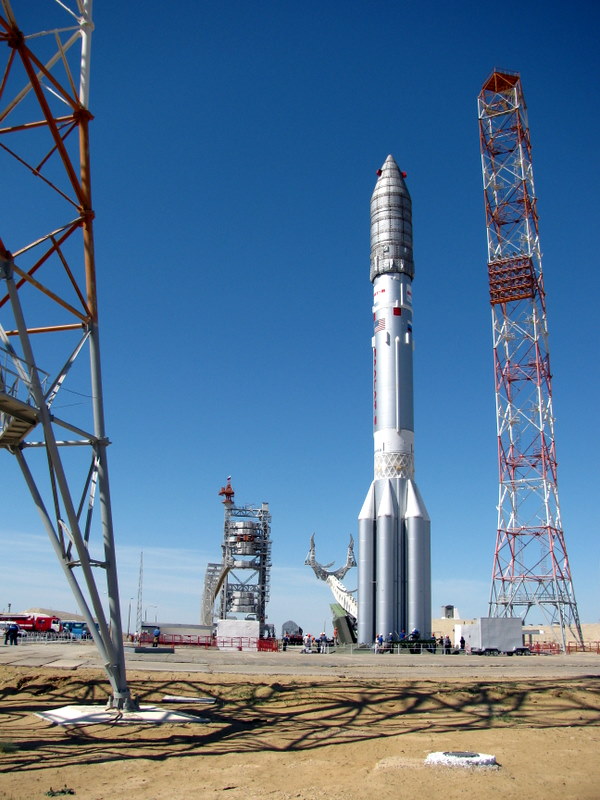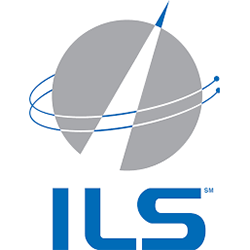Proton

Proton-M rocket preparing to launch the BADR-5 (Arabsat-5B) satellite, May 2010. The Proton is the largest Russian launch vehicle. It is capable of launching heavy space station components to LEO or carrying satellites directly to geostationary orbit. Since the mid 1990s it has been marketed by International Launch Services (ILS), a joint venture between Khrunichev Space Center and RSC Energia of Russia and Lockheed Martin of the United States.
About International Launch Services
International Launch Services
1875 Explorer Street, Suite 700
Reston, VA 20190
+! 571-633-7400
+1 571-633-7500 fax
Web site: www.ilslaunch.com
Jim Bonner
Chief Technical Officer and Vice President Programs
Phone: +1 (571) 633-7457
Fax: +1 (571) 633-7536
j.bonner@ilslaunch.com
Wendy Mihalic
Vice President, Marketing, Sales and Communications
Phone: +1 (571) 633-7452
Fax: +1 (571) 633-7576
w.mihalic@ilslaunch.com
Proton Vehicle Descriptions
General Description

Proton-M rocket prepared for launch. Launch campaign BADR-5 (Arabsat-5B). Courtesy Pavel Kolotilov
National Origin
RussiaMain Organization
Summary
Flight Rate
Estimated Launch Price
Retired.
Spaceports
| Launch Site | Baikonur LC 81 Pads 23 and 24 and LC 200 Pad 39 |
| Location | 46.1° N, 63.0° E |
| Available Inclinations | 51.6, 64.8, and 72.7 deg directly. All others require plane change maneuvers. |
Primary Missions
Three stage: space station deployment
Four stage: Heavy GEO payloads, planetary missions, GLONASS deployment
Status
Key Organizations
Marketing Organization
Launch Service Provider
Prime Contractor
Performance
Adapter mass must be subtracted to determine separated spacecraft mass. Performance reflects commercial configuration and flight profile. Maximum performance for Russian government missions is higher. See Performance section for more details.
| 200 km (108 nmi), 51.6 deg | 19,760 kg (43,560 lbm) |
| 185 km (100 nmi), 90 deg | 3620 kg (7980 lbm) |
| Space Station Orbit: 186×222 km (100×120 nmi), 51.6 deg | 19,760 kg (43,560 lbm). The three-stage Proton delivers spacecraft to low orbit, then the spacecraft must use onboard propulsion to raise the orbit to space station altitude. |
| Sun-Synchronous Orbit: 800 km (432 nmi), 98.6 deg | 3620 kg (7980 lbm) |
| GTO: 1500 m/sec Delta-V to 650 | 4350 kg (9590 lbm)—two upper-stage burns 4930 kg (10,846 lbm)—three upper-stage burns |
| Geostationary Orbit | 1880 kg (4145 lbm) |
General Description

Proton-M rocket prepared for launch. Launch campaign BADR-5 (Arabsat-5B). Courtesy Pavel Kolotilov
National Origin
RussiaMain Organization
Summary
Flight Rate
Estimated Launch Price
Price negotiable
Spaceports
| Launch Site | Baikonur LC 81 Pads 23 and 24 and LC200 Pad 39 |
| Location | 46.1° N, 63.0° E |
| Available Inclinations | 51.6, 64.8, and 72.7 deg directly. All others require plane change maneuvers. |
Primary Missions
Intermediate to heavy GTO and GEO payloads
Status
Key Organizations
Marketing Organization
Launch Service Provider
Prime Contractor
Performance
Adapter mass must be subtracted to determine separated spacecraft mass. Performance reflects commercial configuration and flight profile. Maximum performance for Russian government missions is higher. See Performance section for more details.
| 180 km (97.2 nmi), 51.5 deg | 23,700 kg (52,250 lbm) |
| 185 km (100 nmi), 90 deg | ? |
| Space Station Orbit: 186×222 km (100×120 nmi), 51.6 deg | 23,700kg (52,250 lbm). The three-stage Proton delivers spacecraft to low orbit, then the spacecraft must use onboard propulsion to raise the orbit to space station altitude. |
| Sun-Synchronous Orbit: 800 km (432 nmi), 98.6 deg | ? |
| GTO: 1500 m/sec Delta-V to 650 | 6300 kg (13,889 lbm) |
| Geostationary Orbit | 3300 kg (7275 lbm) |
Flight Record (through 31 July 2021)
| Total Orbital Flights | 112 |
| Launch Vehicle Successes | 101 |
| Launch Vehicle Partial Failures | 2 |
| Launch Vehicle Failures | 9 |
Proton is launched from the Baikonur Cosmodrome in Kazakhstan. Because Baikonur is a landlocked launch site, specific drop zones are reserved for the impact of the first stage, second stage, and payload fairing. These drop zones are typically about 310 km (190 mi) downrange for the first stage, and 1985 km (1230 mi) downrange for the second stage and payload fairing. Proton is therefore constrained to fly along one of three launch azimuths that are aligned with these zones. The basic three-stage Proton does not have an upper-stage restart capability, and therefore cannot reach orbits with perigees higher than approximately 200 km (108 nmi). To reach higher orbits or other inclinations, Proton delivers the payload plus an upper stage to a standard 180–200 km (97–108 nmi) circular support orbit. The upper stage or spacecraft propulsion system then performs orbit raising and/or plane change maneuvers. (While the azimuth restrictions limit performance, this approach does have the advantage of standardizing the trajectory and flight software of the lower three stages.)
Historically the Block DM upper stage has been used for most Proton K flights. Performance of the three-stage Proton configurations to typical support orbits is provided subsequently. Performance varies depending on the fairing separation time. Two separation times are available, each of which meets impact point restrictions. Payload fairing separation at 185 s results in higher performance than the 350 s separation time, but also exposes the payload to heating rates much higher than are standard for Western spacecraft. An intermediate time is used by Proton M to enable full performance for Western satellite missions. Performance for Russian government missions, which may use smaller payload fairings and the early fairing jettison time, can be higher than the commercial advertised performance. A comparison is shown below.
| Proton M/Breeze M | |||
| Commercial | Russian Government | ||
| 180 km (97.2 nmi), 51.5 deg | 22,000 kg (48,400 lbm) | 23,700 kg (52,250 lbm) | |
| Geostationary Orbit (GSO) | 3200 kg (7040 lbm) | 3300 kg (7275 lbm) | |
The Block DM is a LOX/kerosene-fueled stage with a capability for up to seven engine restarts (five have been demonstrated) and an on-orbit lifetime of 24
h, or longer with additional modifications. This allows the Block DM to deliver payloads directly to GSO or to coast for several revolutions in the support orbit
for proper phasing and then deliver a spacecraft to GSO close to its planned longitude. Russian domestic satellites have generally been delivered directly to
GSO, but commercial spacecraft are typically delivered to a GTO with the apogee and perigee optimized for the particular mission. For certain GTO orbits, a
three-burn trajectory can be used in which the Block DM stage is delivered to a suborbital trajectory and performs its first burn to reach the parking orbit. This
results in higher performance as shown subsequently. Performance is increased for certain domestic Russian missions by using the lighter Block D2 stage,
which lacks the avionics compartment of the Block DM. This results in a performance improvement of approximately 800 kg (1750 lbm), but requires that the
spacecraft be capable of controlling the stage. This configuration is used primarily for Russian planetary spacecraft.
The Block DM is also used for many Proton LEO missions (for example, on three Iridium deployment flights), to deliver the payload to the desired inclination
and altitude. However, the Block DM has propellant loading constraints that impact its performance for LEO and other low-energy missions. A
minimum of 11,500 kg (25,350 lbm) of propellant must be loaded onto the Block DM, even for missions that do not require this much capability from the
stage. As a result of carrying this surplus propellant, the available payload mass is limited and is largely independent of altitude for LEO missions.
Missions to higher altitudes simply burn more of the propellant load, leaving a smaller surplus.
The new Breeze M is a modified version of the Breeze KM upper stage developed for the Rockot space launch vehicle. Like the Block DM, the Breeze
M is capable of 24 h of on-orbit operations and multiple restarts. However, the Breeze M main engine has a much lower thrust (and therefore a longer
burn time) than the Block DM. As a result, the apogee raising maneuver for GTO missions is usually, but not always, split into two burns. The first puts
the Breeze M and payload into an intermediate elliptical orbit, and the second raises the apogee to the planned altitude.
Performance values shown are for commercial payloads. The standard commercial payload fairing is assumed for Block DM missions. The short version
of the Breeze M fairing is assumed. The larger Breeze M payload fairing reduces payload capacity by roughly 100 kg (220 lbm) for GTO missions.
The later of two available fairing separation times is used to keep free molecular heating rates at acceptable levels for commercial payloads. Domestic
Russian payloads typically use smaller fairings, and in some cases separate the payload fairing earlier, resulting in higher performance than shown here.
The performance shown is the payload systems mass, which includes both the spacecraft mass and the mass of the payload adapter and any additional payload support hardware such as cable harnesses. Typical mass for Block DM adapters is 110–155 kg (243–342 lbm). Typical mass for Breeze M adapters is 110 kg (240 lbm). Sufficient flight performance reserve is included to provide 3 sigma confidence of performance levels.
Three-Stage Proton Performance
| Orbit | Proton M/Briz M |
| 180 km (97.2 nmi), 51.5 deg | 22,000 kg (48,400 lbm) |
| 190 km (103 nmi), 64.8 deg | 20,610 kg (45,435 lbm) |
| 170 km (92 nmi), 72.7 deg | 19,975 kg (44,035 lbm) |

